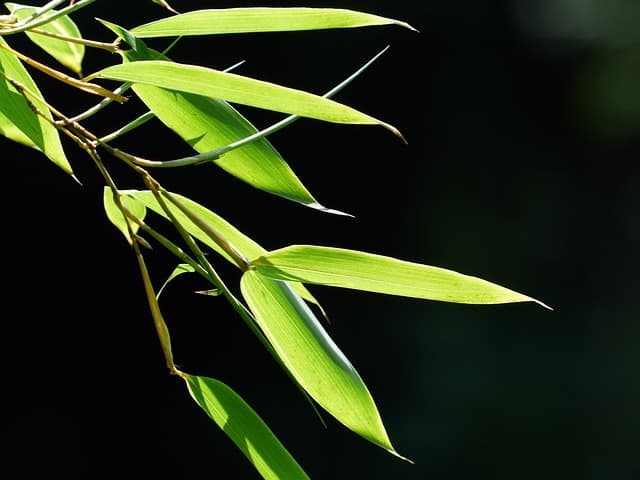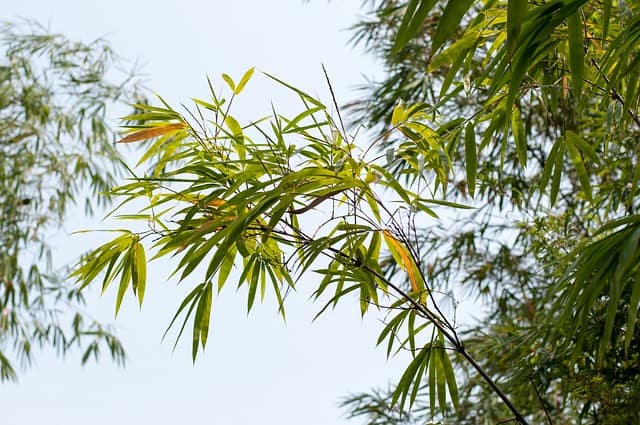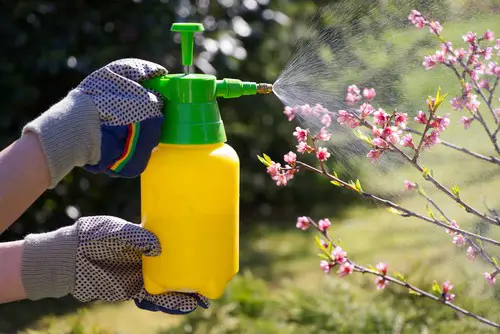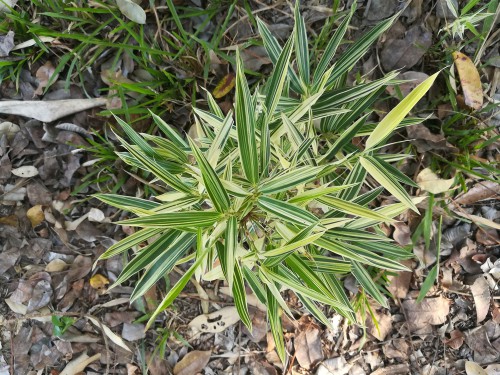Bamboo is a popular ornamental plant that adds a touch of elegance to any garden or home. However, if you’ve noticed brown spots on your bamboo leaves, it’s important to identify the cause and take action to prevent further damage.
Brown spots on bamboo leaves can be caused by a variety of factors, including pests, diseases, and environmental stressors.
Understanding the causes of brown spots on bamboo leaves is crucial to preventing further damage to your plant. Brown spots on bamboo leaves can be caused by fungal diseases, such as leaf spot diseases, or environmental factors, such as overwatering or underwatering.
Identifying the cause of the brown spots is the first step in determining the best course of action to prevent further damage and restore your plant to health.
Key Takeaways
- Brown spots on bamboo leaves can be caused by pests, diseases, and environmental stressors.
- Identifying the cause of brown spots is crucial to preventing further damage to your plant.
- Preventing and treating brown spots on bamboo leaves involves proper watering, pruning, and using fungicides when necessary.
Also see:
- Brown Spots on Back of Monstera Leaves
- Brown Spots on Cucumber Leaves
- Basil Leaves Turning Yellow with Brown Spots
Understanding Brown Spots on Bamboo Leaves

Brown spots on bamboo leaves can be an indicator of an underlying issue with the plant. These spots can appear on the leaves or the stalk, and they can be caused by a variety of factors. Understanding the causes of brown spots on bamboo leaves can help you identify and address the underlying issue.
One common cause of brown spots on bamboo leaves is poor nutrition. Bamboo plants require a balance of nutrients to grow and thrive, and a lack of certain nutrients can lead to brown spots on the leaves.
For example, a lack of nitrogen can cause the leaves to turn yellow and brown, while a lack of potassium can cause brown spots to appear on the edges of the leaves.
Another common cause of brown spots on bamboo leaves is overwatering. Bamboo plants require well-draining soil and should not be overwatered. Overwatering can lead to root rot, which can cause brown spots to appear on the leaves.
In addition, overwatering can also lead to fungal infections, which can cause brown spots to appear on the leaves.
Pests can also be a cause of brown spots on bamboo leaves. Some common pests that can affect bamboo plants include spider mites, aphids, and mealybugs. These pests can damage the leaves and cause brown spots to appear.
In some cases, brown spots on bamboo leaves can be a sign of a more serious issue, such as a disease or infection. For example, bamboo mosaic virus can cause brown spots to appear on the leaves, as well as other symptoms such as yellowing and stunted growth.
Overall, brown spots on bamboo leaves can be a sign of a variety of issues with the plant. By understanding the potential causes of brown spots on bamboo leaves, you can take steps to address the underlying issue and keep your bamboo plant healthy and thriving.
Brown Spots on Bamboo Leaves – 5 Common Problems
Bamboo is a popular ornamental plant that adds beauty to any garden. However, brown spots on bamboo leaves can be a cause of concern for many gardeners. There are several reasons why bamboo leaves may develop brown spots.
In this section, we will explore the various causes of brown spots on bamboo leaves and how to prevent them.
1. Watering Issues

Watering issues are one of the most common causes of brown spots on bamboo leaves. Overwatering or underwatering can both lead to brown spots. Overwatering can cause root rot, which can damage the roots and prevent them from absorbing nutrients properly.
On the other hand, underwatering can cause the leaves to dry out and develop brown spots. It is important to water bamboo plants regularly and ensure that the soil is moist but not waterlogged.
2. Soil and Fertilizer Factors
Soil and fertilizer factors can also cause brown spots on bamboo leaves. The soil should be well-draining and rich in nutrients. Bamboo plants require regular fertilization to maintain their health. However, using the wrong type of fertilizer or applying too much fertilizer can cause brown spots.
It is important to use a bamboo-specific fertilizer or a lawn fertilizer that is low in nitrogen.
3. Insect and Pest Infestation
Insect and pest infestation is another common cause of brown spots on bamboo leaves. Mealybugs, aphids, mites, and scale insects are some of the common insect pests that can infest bamboo plants.
These insects feed on the sap of the plant and excrete a sticky substance called honeydew. The honeydew can attract other insects and cause the development of sooty mold, which can lead to brown spots on the leaves.
4. Disease and Fungal Infections
Disease and fungal infections can also cause brown spots on bamboo leaves. Fungal diseases such as leaf spot and sooty mold can cause brown spots on the leaves. Bacterial infections can also cause brown spots.
Bamboo mosaic virus is a viral disease that can cause brown spots on the leaves. It is important to use fungicides or copper-based fungicide to prevent the spread of fungal infections.
5. Environmental Conditions
Environmental conditions such as heat stress, low humidity, and winter damage can also cause brown spots on bamboo leaves. Bamboo plants prefer shade or partial sunlight and can be damaged by too much heat or direct sunlight.
Low humidity can cause the leaves and soil to lose moisture at an increased rate, resulting in dehydration and brown leaf spots. Chilly weather can burn the leaves of many types of bamboo, causing brown spots.
Identifying Brown Spots on Bamboo Leaves

Bamboo plants are known for their lush green foliage, but sometimes brown spots can appear on the leaves. These spots can be a sign of various problems, ranging from nutrient deficiencies to pests and diseases.
In this section, we will discuss how to identify brown spots on bamboo leaves and what they might indicate about the plant’s health.
Spotting Common Symptoms
Brown spots on bamboo leaves can take many forms, and their appearance can vary depending on the underlying cause. Some common symptoms to look out for include:
- Brown tips: If the tips of the bamboo leaves turn brown, it may be a sign of fertilizer burn or winter damage. Over-fertilization can cause salt buildup in the soil, which can harm the plant’s roots and lead to brown tips. Winter damage can occur when bamboo plants are exposed to cold temperatures or dry air.
- Yellowing leaves: If the leaves turn yellow before developing brown spots, it may be a sign of a nutrient deficiency. Bamboo plants need a balanced diet of nitrogen, phosphorus, and potassium to grow healthy leaves. A lack of any of these nutrients can cause yellowing and brown spots.
- Black spots: If the brown spots on the bamboo leaves are accompanied by black spots or lesions, it may be a sign of a fungal or bacterial infection. These infections can spread quickly and cause significant damage to the plant if left untreated.
Examining the Plant’s Overall Health
When trying to identify the cause of brown spots on bamboo leaves, it’s important to examine the plant’s overall health. Healthy bamboo plants should have vibrant green leaves that are free from damage and disease. Some signs that a bamboo plant may be unhealthy include:
- Browning leaves: If the bamboo leaves are turning brown and falling off, it may be a sign of a serious problem. This could be due to a lack of water, root rot, or a pest infestation.
- Wilting or drooping: If the bamboo leaves are wilting or drooping, it may be a sign of underwatering or overwatering. Bamboo plants need moist but well-draining soil to grow properly.
- Turning brown or dead: If the bamboo leaves are turning brown or appear dead, it may be a sign of a severe pest or disease problem. In some cases, the entire plant may need to be removed to prevent the spread of the problem to other plants.
By examining the symptoms and overall health of the bamboo plant, you can get a better idea of what might be causing the brown spots on the leaves. If you’re unsure of the cause, it’s always a good idea to consult with a gardening expert or plant specialist to get a professional opinion.
Prevention and Treatment of Brown Spots
Bamboo plants are susceptible to various pests, diseases, and environmental factors that can cause brown spots on their leaves. The earlier the brown spots are addressed, the more likely the bamboo plant can recover. In this section, we will discuss the prevention and treatment of brown spots on bamboo leaves.
1. Pruning and Maintenance
Pruning is an essential maintenance practice to keep bamboo plants healthy and prevent the spread of diseases. Aggressive pruning can help remove infected leaves and promote new growth.
Use pruning shears or scissors to cut off diseased leaves at the base of the stem. Make sure to sterilize the tools before and after use to prevent the spread of disease.
2. Using Insecticides and Fungicides

Insecticidal soap and neem oil are effective in controlling pests such as mealybugs, aphids, and mites that can cause brown spots on bamboo leaves.
Fungicides such as copper-based fungicide can help control fungal diseases like leaf spot and bamboo mosaic virus. Always follow the label instructions when using insecticides and fungicides.
3. Improving Watering and Feeding Practices
Improper watering and feeding practices can lead to brown spots on bamboo leaves. Overwatering can cause root rot and fungal infections, while underwatering can cause the plant to dry out and become stressed.
Use a well-draining soil mix and water the plant deeply but infrequently. Apply bamboo fertilizer or lawn fertilizer once a month during the growing season to provide essential nutrients.
4. Creating a Healthy Environment
Bamboo plants thrive in moist, well-drained soil and partial shade. Make sure the plant receives enough oxygen and is not overcrowded. Apply a layer of mulch around the base of the plant to retain moisture and prevent weeds.
Regularly clean the plant’s leaves to prevent the buildup of dust and debris that can attract pests and cause fungal infections.
5. Dealing with Pests and Diseases
Mealybugs, aphids, mites, and scale are common pests that can cause brown spots on bamboo leaves. Use insecticidal soap or neem oil to control the infestation.
Fungal diseases such as leaf spot, root rot, and mold can also cause brown spots on bamboo leaves. Use copper-based fungicides to control the infection and remove infected leaves and stems.
Conclusion
Bamboo plants are a popular addition to many gardens due to their unique appearance and ability to grow quickly. However, brown spots on bamboo leaves can be a cause for concern for many gardeners. After researching the topic, it is clear that there are several reasons why brown spots may appear on bamboo leaves.
One of the most common causes of brown spots on bamboo leaves is overwatering or poor drainage. When the soil is waterlogged, it can prevent oxygen from reaching the roots, which can lead to root rot and brown spots on the leaves.
To avoid this issue, gardeners should ensure that the soil is well-draining and not water the bamboo plant too frequently.
Another cause of brown spots on bamboo leaves is exposure to too much heat or direct sunlight. Most bamboo varieties prefer shade or partial sunlight, so if the plant is exposed to too much sun, it may develop brown spots on the leaves.
Gardeners can prevent this issue by ensuring that the bamboo plant is placed in a shaded area or protected from direct sunlight during the hottest parts of the day.
Bamboo plants can also be susceptible to pests and diseases, which can cause brown spots on the leaves. Gardeners should regularly inspect their bamboo plants for signs of pests or diseases, such as aphids or bamboo mosaic virus.
If any issues are detected, gardeners should take immediate action to treat the problem and prevent further damage to the plant.
Overall, brown spots on bamboo leaves can be caused by a variety of factors, including overwatering, exposure to too much heat or direct sunlight, and pests or diseases.
By understanding the causes of brown spots on bamboo leaves, gardeners can take steps to prevent and treat this issue, ensuring that their bamboo plants remain healthy and vibrant.
Frequently Asked Questions
What causes brown spots on bamboo leaves?
Brown spots on bamboo leaves can be caused by various factors such as fungal and bacterial infections, pests, and environmental stressors. Overwatering or underwatering can also cause brown spots on bamboo leaves.
How do you treat brown spots on bamboo leaves?
Treating brown spots on bamboo leaves depends on the underlying cause. If the cause is a fungal or bacterial infection, it is best to remove the affected leaves and treat the plant with a fungicide or bactericide.
If the cause is pests, it is recommended to use an insecticide to control the infestation. Additionally, maintaining proper watering and humidity levels can prevent further brown spots from appearing.
What are the common pests that cause brown spots on bamboo leaves?
Common pests that cause brown spots on bamboo leaves include spider mites, mealybugs, and scale insects. These pests feed on the sap of the plant, causing brown spots and discoloration on the leaves.
Can indoor bamboo leaves turn brown due to pests?
Yes, indoor bamboo leaves can turn brown due to pests. Indoor bamboo plants are susceptible to spider mites, mealybugs, and scale insects, which can cause brown spots and discoloration on the leaves.
What are the white spots on lucky bamboo leaves?
White spots on lucky bamboo leaves are usually caused by powdery mildew, a fungal infection that thrives in humid environments. To treat powdery mildew, remove the affected leaves and treat the plant with a fungicide.
Why do outdoor bamboo leaves turn brown?
Outdoor bamboo leaves can turn brown due to various factors such as fungal and bacterial infections, pests, and environmental stressors.
Overwatering or underwatering can also cause brown spots on outdoor bamboo leaves. Additionally, exposure to extreme temperatures and direct sunlight can cause the leaves to turn brown.

Hey, I’m Lisa and I’ve been an avid gardener for over 30 years. I love writing, talking and living in the garden! Feel free to connect with me on my socials below

